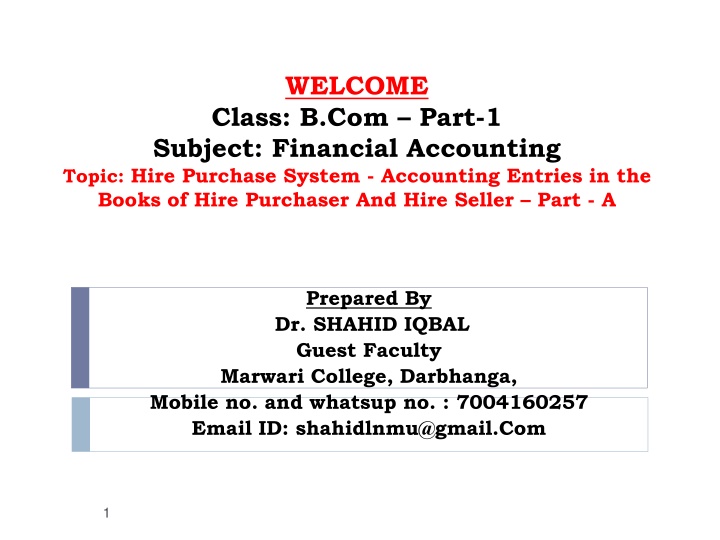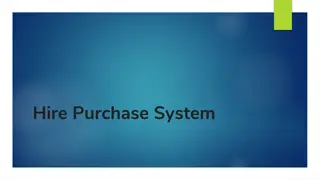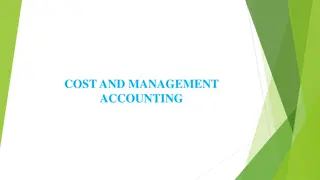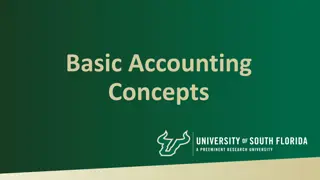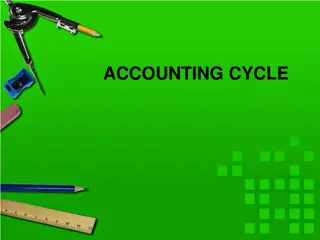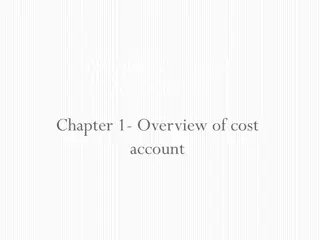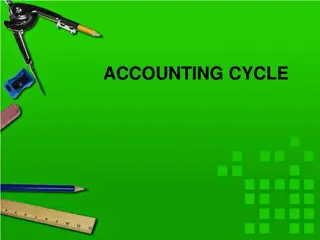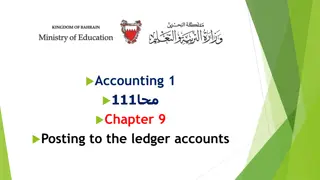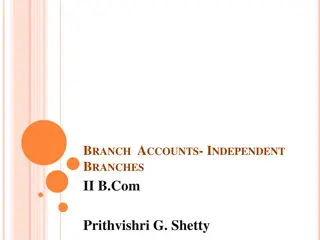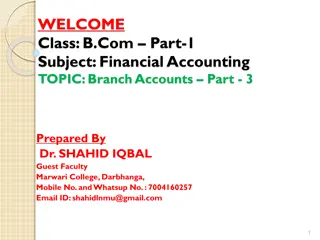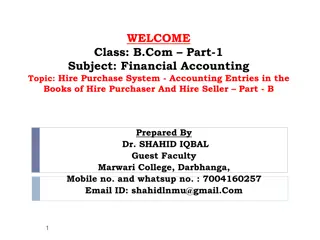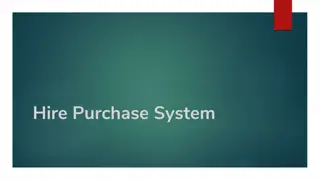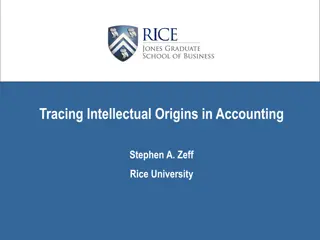Accounting Entries for Hire Purchase Transactions
Different hire purchase transactions are recorded in the books of both the hire vendor/seller and hire purchaser through various accounting methods like the Asset Accrual Method. This method involves gradual capitalization and recording installment payments towards the cash price of the asset. Depreciation is also accounted for, and expenses are transferred to the Profit and Loss Account annually.
Download Presentation

Please find below an Image/Link to download the presentation.
The content on the website is provided AS IS for your information and personal use only. It may not be sold, licensed, or shared on other websites without obtaining consent from the author.If you encounter any issues during the download, it is possible that the publisher has removed the file from their server.
You are allowed to download the files provided on this website for personal or commercial use, subject to the condition that they are used lawfully. All files are the property of their respective owners.
The content on the website is provided AS IS for your information and personal use only. It may not be sold, licensed, or shared on other websites without obtaining consent from the author.
E N D
Presentation Transcript
WELCOME Class: B.Com Part-1 Subject: Financial Accounting Topic: Hire Purchase System - Accounting Entries in the Books of Hire Purchaser And Hire Seller Part - A Prepared By Dr. SHAHID IQBAL Guest Faculty Marwari College, Darbhanga, Mobile no. and whatsup no. : 7004160257 Email ID: shahidlnmu@gmail.Com 1
Accounting Entries For Hire Purchase Transactions In The Books Of Hire Purchaser And Hire Seller Different hire purchase transactions are recorded in the books of both the hire vendor/seller and hire purchaser. Further, one or more method/s is/are available for recording the hire purchase transactions in the books of each of the two parties. Summary is presented below in figure followed by a detailed analysis. Methods of Accounting for Hire Purchase Transactions: 2
I (A) Asset Accrual Method: This method is also called, Proportional Capitalization Method, Gradual Capitalization Method or Actual Cash Price Paid Method. As the name itself indicates, this method assumes that the asset accrues to the hirer gradually to the extent of payment made towards the cash price of the asset acquired on hire purchase basis. Therefore, in the books of the hirer or hire purchaser, Asset Account is debited to the extent of only the installment amount paid towards the cash price of the asset. In other words, Asset Account is debited with the installment towards cash price of the asset every time installment is paid. The salient features of this method are as follows. (1) As both the amount due and the interest due thereon (i.e., on the amount due) are zero at the time of signing the hire purchase agreement (i.e., at the time of delivery of the asset), down payment, if any, made is only towards the cash price of the asset (but not towards interest also). Therefore, the amount of down payment is debited to Asset A/c crediting Cash or Bank A/c. 3
(2) Each installment payable is towards both the cash price of the asset (called, installment cash price) and the interest accrued on the amount outstanding (from the date of immediately preceding installment paid and the date of the current installment payment). When the installment is due for payment, a portion of installment towards cash price is debited to Assets A/c and the remaining portion pertaining to interest is debited to Interest A/c crediting Hire Seller s A/c. When the payment is made, Hire Seller s A/c is debited and Cash or Bank A/c is credited. (3) Since the hire purchaser starts using the asset acquired under hire purchase system, the asset is subject to wear and tear. Hence, depreciation is provided in the books of the hirer, usually, at the end of each accounting year. Therefore, Depreciation A/c is debited and Asset A/c is credited. (4) As both the amounts of interest paid (as a part of installment amount) and depreciation charged constitute the expenses (i.e., items of Nominal Accounts), both are transferred to Profit and Loss A/c at the end of each accounting year by debiting Profit and Loss A/c (for the aggregate of interest and depreciation) crediting Interest A/c (for the amount of interest) and Depreciation A/c (for the amount of depreciation) 4
With this introduction about the nature of Asset Accrual Method, the journal entries for different hire purchase transactions in the books of hire purchaser are presented below. (1) For recording down payment made at the time of signing the hire purchase agreement, the following entry is passed. It may be noted here that if no down payment is made, the following entry is not required. Asset A/c (Being the amount of down payment made) Dr. To Bank/Cash A/c Alternatively, the following two entries may be passed: Asset A/c To Hire Seller s A/c (Being the down payment due) Dr. Hire Seller s A/c To Bank/Cash A/c (Being the payment of down payment) Dr. 5
The number of journal entries for the subsequent installment payment/s (subsequent to down payment or signing of hire purchase agreement if no down payment is made) depends upon the whether the installments are paid annually or more frequently (such as half-yearly, quarterly, monthly, etc). Therefore, both the cases are analyzed separately below. When the installments are paid annually, the following four entries should be passed one each for recording (i) installment amount due, (ii) payment of installment amount, (iii) for charging depreciation on the asset acquired on hire purchase basis, and (iv) for transferring the amounts of interest and depreciation to the Profit and Loss A/c as presented below. 6
(2) For recording the amount of instalment due to the hire vendor, the following entry is passed. Asset A/c Interest A/c (Being the instalment due) Dr. Dr To Hire Seller s A/c (3) For recording the payment of instalment amount to the hire vendor, the following entry is passed. Hire Seller s A/c Dr. To Bank/Cash A/c (Being instalment amount paid to hire seller) (4) For recording the depreciation on the asset, the following entry is passed at the end of the year. Depreciation A/c Dr. To Asset A/c (Being the amount of depreciation charge) 7
(5) For transferring the amounts of interest and depreciation to the Profit and Loss A/c, the following entry is passed at the end of the year Profit and Loss A/c To Interest A/c To Depreciation A/c (Being the amounts of interest and depreciation transferred to Profit and Loss A/c) Dr. If the instalments are paid more frequently such as half-yearly, quarterly, etc., then two sets of entries are passed one set of entries for each of all instalments (for the accounting year) except the last instalment, and the second set of entries for the last instalment (of the accounting year). The following two entries are passed at the end of each of the instalments (except the last instalment for the accounting year) in the year (entries for the instalment due and paying the instalment. These two entries are same as that for annual instalments). 8
(6) For recording the amount of instalment due to the hire vendor, the following entry is passed. Asset A/c Interest A/c (Being the amount of instalment due towards both the cash price and interest) Dr. Dr. To Hire Seller s A/c (7) For recording the payment of instalment amount to the hire vendor, the following entry is passed. Hire Seller s A/c Dr. To Bank/Cash A/c (Being the amount of instalment paid) Further, all the four entries (as in the case of annual instalment) are passed at the end of the accounting year (i.e., with the payment of last instalment of the accounting year) as presented below. 9
(8) For recording the amount of last instalment of the accounting year due to the hire vendor, the following entry is passed. Asset A/c Interest A/c (Being the instalment due towards both the cash price and interest) Dr. Dr. To Hire Seller s A/c (9) For recording the payment of last instalment amount of the accounting year to the hire vendor, the following entry is passed. Hire Seller s A/c Dr. To Bank/Cash A/c (Being the amount of instalment paid) (10) For recording the depreciation on the asset for the whole accounting year, the following entry is passed at the end of the year. Depreciation A/c Dr. To Asset A/c (Being the amount of depreciation charge) 10
(11) For transferring the amounts of interest and depreciation (for the whole year) to the Profit and Loss A/c, the following entry is passed at the end of the year. Profit and Loss A/c To Interest A/c To Depreciation A/c (Being the amounts of interest and depreciation transferred to Profit and Loss A/c) Dr. Thank You 11
